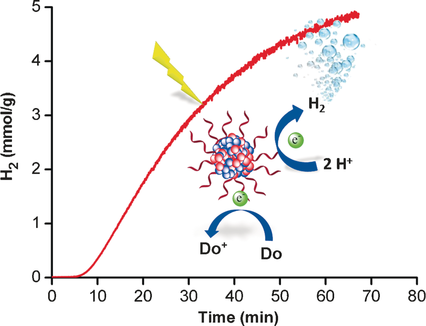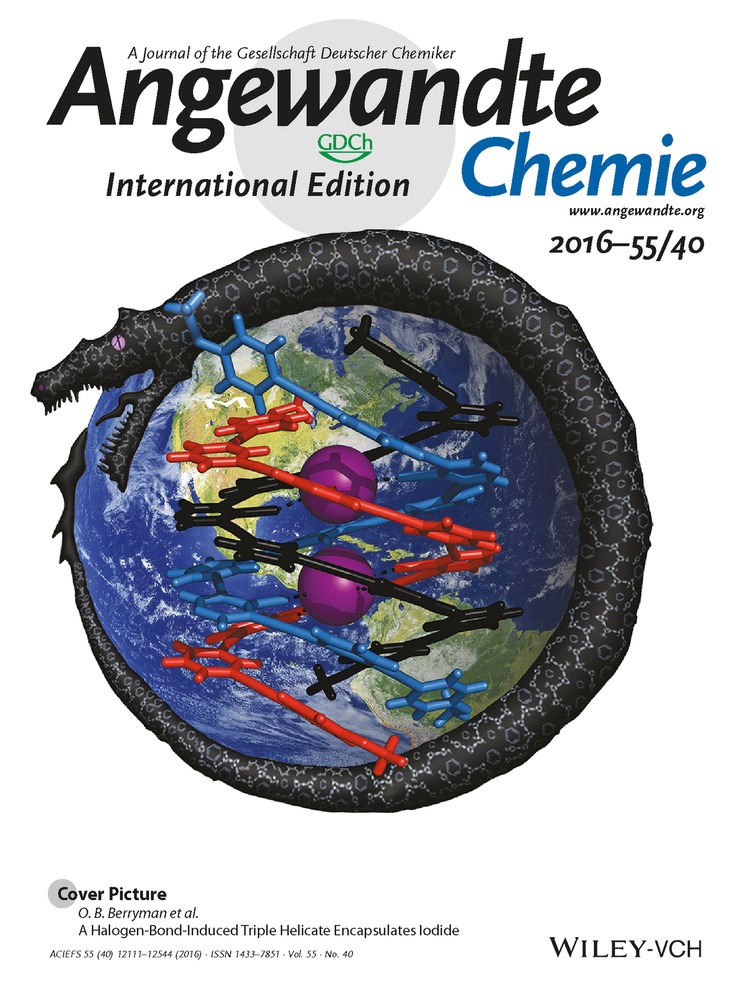Organic Polymer Dots as Photocatalysts for Visible Light-Driven Hydrogen Generation
Dr. Lei Wang
Department of Chemistry, Ångström Laboratory, Physical Chemistry, Uppsala University, 751 20 Uppsala, Sweden
Search for more papers by this authorRicardo Fernández-Terán
Department of Chemistry, Ångström Laboratory, Physical Chemistry, Uppsala University, 751 20 Uppsala, Sweden
Search for more papers by this authorLei Zhang
Department of Chemistry, Ångström Laboratory, Physical Chemistry, Uppsala University, 751 20 Uppsala, Sweden
Search for more papers by this authorDr. Daniel L. A. Fernandes
Department of Chemistry, Ångström Laboratory, Physical Chemistry, Uppsala University, 751 20 Uppsala, Sweden
Search for more papers by this authorLei Tian
Department of Chemistry, Ångström Laboratory, Physical Chemistry, Uppsala University, 751 20 Uppsala, Sweden
Search for more papers by this authorDr. Hong Chen
Berzelii Center EXSELENT on Porous Materials and Department of Materials and Environmental Chemistry, Stockholm University, 106 91 Stockholm, Sweden
Search for more papers by this authorCorresponding Author
Prof. Dr. Haining Tian
Department of Chemistry, Ångström Laboratory, Physical Chemistry, Uppsala University, 751 20 Uppsala, Sweden
Search for more papers by this authorDr. Lei Wang
Department of Chemistry, Ångström Laboratory, Physical Chemistry, Uppsala University, 751 20 Uppsala, Sweden
Search for more papers by this authorRicardo Fernández-Terán
Department of Chemistry, Ångström Laboratory, Physical Chemistry, Uppsala University, 751 20 Uppsala, Sweden
Search for more papers by this authorLei Zhang
Department of Chemistry, Ångström Laboratory, Physical Chemistry, Uppsala University, 751 20 Uppsala, Sweden
Search for more papers by this authorDr. Daniel L. A. Fernandes
Department of Chemistry, Ångström Laboratory, Physical Chemistry, Uppsala University, 751 20 Uppsala, Sweden
Search for more papers by this authorLei Tian
Department of Chemistry, Ångström Laboratory, Physical Chemistry, Uppsala University, 751 20 Uppsala, Sweden
Search for more papers by this authorDr. Hong Chen
Berzelii Center EXSELENT on Porous Materials and Department of Materials and Environmental Chemistry, Stockholm University, 106 91 Stockholm, Sweden
Search for more papers by this authorCorresponding Author
Prof. Dr. Haining Tian
Department of Chemistry, Ångström Laboratory, Physical Chemistry, Uppsala University, 751 20 Uppsala, Sweden
Search for more papers by this authorGraphical Abstract
Abstract
For the first time, organic semiconducting polymer dots (Pdots) based on poly[(9,9′-dioctylfluorenyl-2,7-diyl)-co-(1,4-benzo-{2,1′,3} thiadiazole)] (PFBT) and polystyrene grafting with carboxyl-group-functionalized ethylene oxide (PS-PEG-COOH) are introduced as a photocatalyst towards visible-light-driven hydrogen generation in a completely organic solvent-free system. With these organic Pdots as the photocatalyst, an impressive initial rate constant of 8.3 mmol h−1 g−1 was obtained for visible-light-driven hydrogen production, which is 5-orders of magnitude higher than that of pristine PFBT polymer under the same catalytic conditions. Detailed kinetics studies suggest that the productive electron transfer quench of the excited state of Pdots by an electron donor is about 40 %. More importantly, we also found that the Pdots can tolerate oxygen during catalysis, which is crucial for further application of this material for light-driven water splitting.
Supporting Information
As a service to our authors and readers, this journal provides supporting information supplied by the authors. Such materials are peer reviewed and may be re-organized for online delivery, but are not copy-edited or typeset. Technical support issues arising from supporting information (other than missing files) should be addressed to the authors.
| Filename | Description |
|---|---|
| anie201607018-sup-0001-misc_information.pdf1.9 MB | Supplementary |
Please note: The publisher is not responsible for the content or functionality of any supporting information supplied by the authors. Any queries (other than missing content) should be directed to the corresponding author for the article.
References
- 1
- 1aS. Chu, A. Majumdar, Nature 2012, 488, 294–303;
- 1bL. Hammarström, S. Hammes-Schiffer, Acc. Chem. Res. 2009, 42, 1859–1860.
- 2M. G. Walter, E. L. Warren, J. R. McKone, S. W. Boettcher, Q. Mi, E. A. Santori, N. S. Lewis, Chem. Rev. 2010, 110, 6446–6473.
- 3
- 3aX. Li, M. Wang, S. Zhang, J. Pan, Y. Na, J. Liu, B. Åkermark, L. Sun, J. Phys. Chem. B 2008, 112, 8198–8202;
- 3bE. S. Andreiadis, M. Chavarot-Kerlidou, M. Fontecave, V. Artero, Photochem. Photobiol. 2011, 87, 946–964;
- 3cT. Kowacs, Q. Pan, P. Lang, L. O'Reilly, S. Rau, W. R. Browne, M. T. Pryce, A. Huijser, J. G. Vos, Faraday Discuss. 2015, 185, 143–170;
- 3dF. Wang, W.-G. Wang, X.-J. Wang, H.-Y. Wang, C.-H. Tung, L.-Z. Wu, Angew. Chem. Int. Ed. 2011, 50, 3193–3197; Angew. Chem. 2011, 123, 3251–3255;
- 3eT. A. White, S. L. H. Higgins, S. M. Arachchige, K. J. Brewer, Angew. Chem. Int. Ed. 2011, 50, 12209–12213; Angew. Chem. 2011, 123, 12417–12421;
- 3fH. Ozawa, M.-a. Haga, K. Sakai, J. Am. Chem. Soc. 2006, 128, 4926–4927.
- 4
- 4aI. Tsuji, H. Kato, H. Kobayashi, A. Kudo, J. Am. Chem. Soc. 2004, 126, 13406–13413;
- 4bJ. Huang, K. L. Mulfort, P. Du, L. X. Chen, J. Am. Chem. Soc. 2012, 134, 16472–16475;
- 4cR. P. Sabatini, W. T. Eckenhoff, A. Orchard, K. R. Liwosz, M. R. Detty, D. F. Watson, D. W. McCamant, R. Eisenberg, J. Am. Chem. Soc. 2014, 136, 7740–7750;
- 4dY.-S. Chen, P. V. Kamat, J. Am. Chem. Soc. 2014, 136, 6075–6082.
- 5X. Wang, K. Maeda, A. Thomas, K. Takanabe, G. Xin, J. M. Carlsson, K. Domen, M. Antonietti, Nat. Mater. 2009, 8, 76–80.
- 6
- 6aS. Cao, J. Yu, J. Phys. Chem. Lett. 2014, 5, 2101–2107;
- 6bJ. Liu, Y. Liu, N. Liu, Y. Han, X. Zhang, H. Huang, Y. Lifshitz, S.-T. Lee, J. Zhong, Z. Kang, Science 2015, 347, 970–974;
- 6cX. Wang, S. Blechert, M. Antonietti, ACS Catal. 2012, 2, 1596–1606;
- 6dS. Cao, J. Low, J. Yu, M. Jaroniec, Adv. Mater. 2015, 27, 2150–2176;
- 6eZ. Zhao, Y. Sun, F. Dong, Nanoscale 2015, 7, 15–37;
- 6fK. Schwinghammer, B. Tuffy, M. B. Mesch, E. Wirnhier, C. Martineau, F. Taulelle, W. Schnick, J. Senker, B. V. Lotsch, Angew. Chem. Int. Ed. 2013, 52, 2435–2439; Angew. Chem. 2013, 125, 2495–2499;
- 6gK. Schwinghammer, M. B. Mesch, V. Duppel, C. Ziegler, J. Senker, B. V. Lotsch, J. Am. Chem. Soc. 2014, 136, 1730–1733.
- 7S. Yanagida, A. Kabumoto, K. Mizumoto, C. Pac, K. Yoshino, J. Chem. Soc.,Chem. Commun. 1985, 474– 475.
- 8M. G. Schwab, M. Hamburger, X. Feng, J. Shu, H. W. Spiess, X. Wang, M. Antonietti, K. Mullen, Chem. Commun. 2010, 46, 8932–8934.
- 9
- 9aJ. Bi, W. Fang, L. Li, J. Wang, S. Liang, Y. He, M. Liu, L. Wu, Macromol. Rapid Commun. 2015, 36, 1799–1805;
- 9bL. Stegbauer, K. Schwinghammer, B. V. Lotsch, Chem. Sci. 2014, 5, 2789–2793;
- 9cV. S. Vyas, F. Haase, L. Stegbauer, G. Savasci, F. Podjaski, C. Ochsenfeld, B. V. Lotsch, Nat. Commun. 2015, 6, 8508.
- 10K. Schwinghammer, S. Hug, M. B. Mesch, J. Senker, B. V. Lotsch, Energy Environ. Sci. 2015, 8, 3345–3353.
- 11J. H. Park, K. C. Ko, N. Park, H.-W. Shin, E. Kim, N. Kang, J. Hong Ko, S. M. Lee, H. J. Kim, T. K. Ahn, J. Y. Lee, S. U. Son, J. Mater. Chem. A 2014, 2, 7656–7661.
- 12K. Kailasam, J. Schmidt, H. Bildirir, G. Zhang, S. Blechert, X. Wang, A. Thomas, Macromol. Rapid Commun. 2013, 34, 1008–1013.
- 13C. Yang, B. C. Ma, L. Zhang, S. Lin, S. Ghasimi, K. Landfester, K. A. I. Zhang, X. Wang, Angew. Chem. Int. Ed. 2016, 55, 9202–9206; Angew. Chem. 2016, 128, 9348–9352.
- 14
- 14aL. Li, Z. Cai, Q. Wu, W.-Y. Lo, N. Zhang, L. X. Chen, L. Yu, J. Am. Chem. Soc. 2016, 138, 7681–7686;
- 14bR. S. Sprick, B. Bonillo, M. Sachs, R. Clowes, J. R. Durrant, D. J. Adams, A. I. Cooper, Chem. Commun. 2016, 52, 10008–10011.
- 15R. S. Sprick, J.-X. Jiang, B. Bonillo, S. Ren, T. Ratvijitvech, P. Guiglion, M. A. Zwijnenburg, D. J. Adams, A. I. Cooper, J. Am. Chem. Soc. 2015, 137, 3265–3270.
- 16R. S. Sprick, B. Bonillo, R. Clowes, P. Guiglion, N. J. Brownbill, B. J. Slater, F. Blanc, M. A. Zwijnenburg, D. J. Adams, A. I. Cooper, Angew. Chem. Int. Ed. 2016, 55, 1792–1796; Angew. Chem. 2016, 128, 1824–1828.
- 17M. Moffitt, K. Khougaz, A. Eisenberg, Acc. Chem. Res. 1996, 29, 95–102.
- 18
- 18aC. Wu, D. T. Chiu, Angew. Chem. Int. Ed. 2013, 52, 3086–3109; Angew. Chem. 2013, 125, 3164–3190;
- 18bC. Wu, T. Schneider, M. Zeigler, J. Yu, P. G. Schiro, D. R. Burnham, J. D. McNeill, D. T. Chiu, J. Am. Chem. Soc. 2010, 132, 15410–15417.
- 19F. C. Spano, C. Silva, Annu. Rev. Phys. Chem. 2014, 65, 477–500.
- 20H. Zhou, F. Liu, X. Wang, H. Yan, J. Song, Q. Ye, B. Z. Tang, J. Xu, J. Mater. Chem. C 2015, 3, 5490–5498.
- 21
- 21aN. Kaeffer, A. Morozan, V. Artero, J. Phys. Chem. B 2015, 119, 13707–13713;
- 21bD. W. Wakerley, E. Reisner, Energy Environ. Sci. 2015, 8, 2283–2295;
- 21cR. Staehle, S. Losse, M. R. Filipovic, I. Ivanović-Burmazović, J. G. Vos, S. Rau, ChemPlusChem 2014, 79, 1614–1621.





